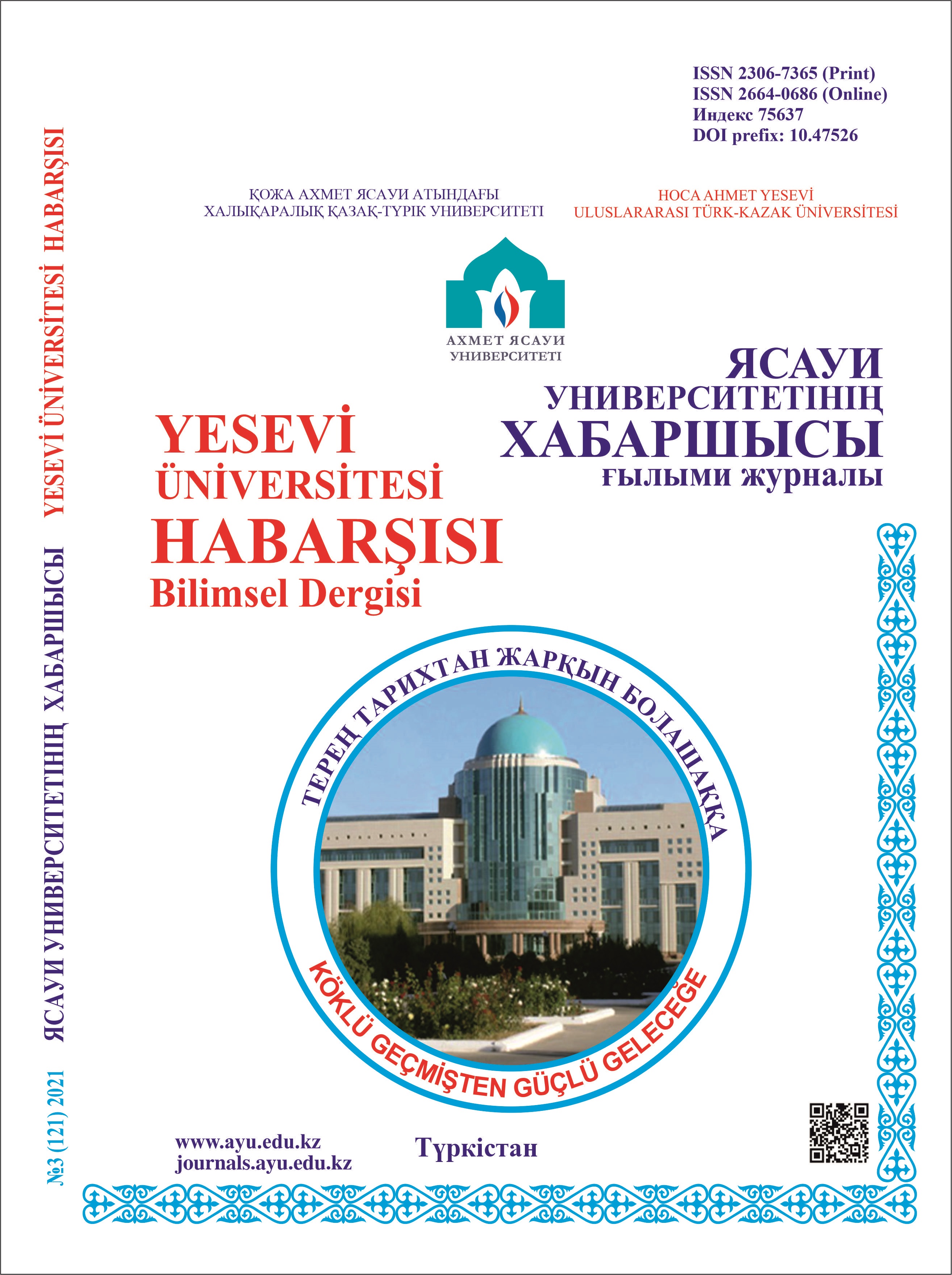STEM EĞİTİMİNE DAYALI» ATOM FİZİĞİ "DERSİNİN ÖĞRETİMİNİN ETKİNLİĞİNİN ARAŞTIRILMASI
139 115
Anahtar Kelimeler:
: atom fiziği, STEM eğitimi, yaratıcılık, deneyim, öğrenme verimliliği, öğrenenler.Özet
Eğitim sisteminde atom fiziği dersinin geleneksel öğretimi teorik olarak derinlemesine öğretilse de pratik uygulama yeterli olmayabilir. Öğrencilere «atom fiziği» dersini öğretirken, STEM (bilim, teknoloji, mühendislik ve matematik) tekniğini kullanarak kursa hakim olmanın etkinliği artar, teorileri pratikte ve gerçek hayatta uygulamayı öğrenirler. STEM tabanlı öğrenme çok önemlidir çünkü bu metodolojiyle öğrenciler atomik ve atom altı süreçleri daha derinlemesine anlayabilirler. Bu araştırma çalışmasının amacı, «atom fiziği» kursunu STEM eğitimine dayalı olarak öğretme yöntemlerini analiz etmek ve öğrencilerin araştırma yeteneklerinin geliştirilmesindeki etkinliği belirlemektir. Ayrıca, atom fiziğinin STEM eğitimine dayalı eğitimin kalitesini artırmadaki etkisini belirlemek. Literatür taraması, literatür sonuçlarının etkinliğini ve güvenilirliğini belirlemek için PRISMA yöntemini ve meta-analiz yöntemini kullandı. Öğrencilerin STEM eğitimine dayalı öğrenmeye karşı tutumlarını belirlemek için «atom fiziği» dersinde öğrenci üniversitelerle ilgili bir anket yapılmıştır. Anket sonuçlarının matematiksel ve istatistiksel analiz yöntemi uygulanmıştır. Hipotez testi, G * Power yazılımı kullanılarak yapıldı. «Atom fiziği» kursunu STEM eğitimine dayalı olarak öğretmek, öğrencilerin bu kursa olan ilgisini artırdı. Öğrencilerin yaratıcı düşünme ve araştırma yeteneklerini etkili bir şekilde geliştirdikleri görülmüştür.
Referanslar
REFERENCES
Sulaeman N., Efwinda S., Putra P.D.A. Teacher readiness in STEM education: voices of Indonesian physics teachers // Journal of Technology and Science Education. – 2022. – Vol. 12, №1. – P. 68–82. https://doi.org/10.3926/jotse.1191
Liu Z.Y., Chubarkova E., Kharakhordina M. Online technologies in STEM education // International Journal of Emerging Technologies in Learning. – 2020. – Vol. 15, №15. – P. 20–32. –https://doi.org/10.3991/ijet.v15i15.14677
Fan I.Y.H., Shum W.K.F. Knowledge Management: The Missing Bonding Discipline of STEM Education // International Journal of Knowledge and Systems Science. – 2023. – Vol. 14, №1. – P. 1–8. https://doi.org/10.4018/IJKSS.323420
Roslina R., Samsudin A., Liliawati W. Effectiveness of Project Based Learning Integrated STEM in Physics Education (STEM-PJBL): Systematic Literature Review (SLR) // Phenomenon: Jurnal Pendidikan MIPA. – 2022. – Vol. 12, №1. – P. 120–139. https://doi.org/10.21580/phen.2022.12.1.11722
Oonsim W., Chanprasert K. Developing critical thinking skills of Grade 11 students by STEM education: a focus on electrostatic in physics // Rangsit Journal of Educational Studies. – 2017. – Vol. 4, №1. – P. 54–59.
Widayanti, Abdurrahman A., Suyatna A. Future physics learning materials based on STEM education: analysis of teachers and students perceptions // Journal of Physics: Conference Series. – 2019. – Vol. 1155. https://doi.org/10.1088/1742-6596/1155/1/012021
Kasianova G. Forming of technical thinking by STEM education of the future teacher of physics // Collection of Scientific Papers Kamianets-Podilsky Ivan Ohienko National University Pedagogical Series. – 2023. – №29. – P. 64–67. https://doi.org/10.32626/2307-4507.2023-29.64-67
Markus L. A needs analysis study in developing quantum physics instructional module for secondary school with an integrated STEM education approach // Borneo International Journal of Education (BIJE). – 2021. – Vol. 2. – P. 69–84. https://doi.org/10.51200/bije.v3i.4113
Lestarani D., Lalang A. C., Manggi I. Development of Articulate Storyline 3-based digital teaching materials on the subject of atomic structure and periodic elements system for SMA/MA students in Class X // Orbital. – 2023. – Vol. 15, №2. – P. 127–132. https://doi.org/10.17807/orbital.v15i2.17959
David H. A role for physicists in STEM education reform // American Journal of Physics. – 2015. – Vol. 83, №2. – P. 101–103. https://doi.org/10.1119/1.4904763
Jan K., Hevesi M., Krivicich L. M., Nho S. J. Meta-analysis // Translational Sports Medicine. – 2023. – P. 201–205. https://doi.org/10.1016/B978-0-323-91259-4.00041-2
Simmonds M. Quantifying the risk of error when interpreting funnel plots // Systematic Reviews. – 2015. – Vol. 4, №1. https://doi.org/10.1186/s13643-015-0004-8
Li G., Zeng J., Tian J., Levine M.A.H., Thabane L Multiple uses of forest plots in presenting analysis results in health research // Journal of Clinical Epidemiology. – 2020. – Vol. 117. – P. 89–98. https://doi.org/10.1016/j.jclinepi.2019.09.021
Murniati, Sofia, Sudirman, Aji D.P. Development of computer-based assessment instruments nuclear physics introduction course as an effort to grade authentically // Jurnal Penelitian Pendidikan IPA. – 2023. – Vol. 9, №7. – P. 5103–5110. https://doi.org/10.29303/jppipa.v9i7.4416
Bitzenbauer P. Development of a test instrument to investigate secondary school students’ declarative knowledge of quantum optics // European Journal of Science and Mathematics Education. – 2021. – Vol. 9, №3. – P. 57–79. https://doi.org/10.30935/scimath/10946
Nurhayati N., Boisandi B. Penggunaan modul berbasis konstruktivis pada mata kuliah fisika kuantum untuk meningkatkan penguasaan konsep ditinjau dari kemampuan matematik mahasiswa // Jurnal Penelitian & Pengembangan Pendidikan Fisika. – 2015. – Vol. 1, №2. – P. 33–38. https://doi.org/10.21009/1.01206
Shi W. Z. The effect of peer interactions on quantum physics: a study from China // Journal of Baltic Science Education. – 2013. – Vol. 12, №2. – P. 152–158. https://doi.org/10.33225/jbse/13.12.152

